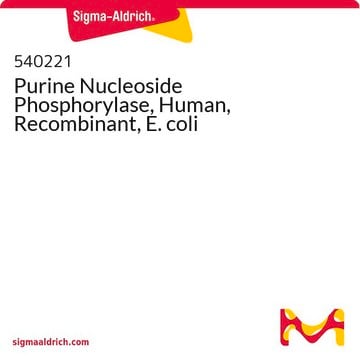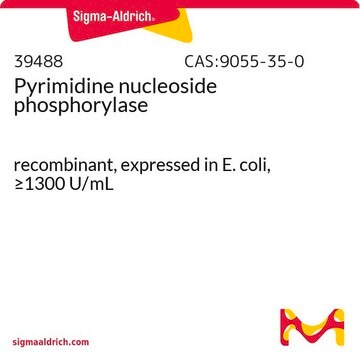N3665
Pyrimidine Nucleoside Phosphorylase from Bacillus subtilis
recombinant, expressed in E. coli, ≥70 units/mg protein
Synonym(s):
PynP
Sign Into View Organizational & Contract Pricing
All Photos(3)
About This Item
Recommended Products
recombinant
expressed in E. coli
form
lyophilized powder
specific activity
≥70 units/mg protein
storage temp.
−20°C
General description
The roles of the residues in the catalytic active site of pyrimidine nucleoside phosphorylase from Bacillis subtilis have been elucidated using hybrid quantum-mechanical/molecular-mechanical methods.
Biochem/physiol Actions
Pyrimidine nucleoside phosphorylase functions in the nucleotide synthesis salvage pathway by catalyzing the reversible phosphorolysis of pyrimidines. Both uridine and thymidine are substrates.
Unit Definition
One unit will convert 1 μmole each of 2′-deoxyuridine and phosphate to uracil and 2-deoxyribose 1-phosphate per minute at pH 7.4 and 37 °C.
signalword
Danger
hcodes
pcodes
Hazard Classifications
Resp. Sens. 1
Storage Class
11 - Combustible Solids
wgk_germany
WGK 1
flash_point_f
Not applicable
flash_point_c
Not applicable
Certificates of Analysis (COA)
Search for Certificates of Analysis (COA) by entering the products Lot/Batch Number. Lot and Batch Numbers can be found on a product’s label following the words ‘Lot’ or ‘Batch’.
Already Own This Product?
Find documentation for the products that you have recently purchased in the Document Library.
Xue-Feng Gao et al.
Journal of structural biology, 154(1), 20-26 (2006-02-14)
Pyrimidine nucleoside phosphorylase (PYNP) catalyzes the reversible phosphorolysis of pyrimidines in the nucleotide synthesis salvage pathway. We have built a model of a closed active conformation of the three-dimensional structure of PYNP from Bacillus subtilis. Using docking, molecular dynamics, and
M J Pugmire et al.
Structure (London, England : 1993), 6(11), 1467-1479 (1998-11-18)
Pyrimidine nucleoside phosphorylase (PYNP) catalyzes the reversible phosphorolysis of pyrimidines in the nucleotide synthesis salvage pathway. In lower organisms (e.g. Bacillus stearothermophilus) PYNP accepts both thymidine and uridine, whereas in mammalian and other higher organisms it is specific for thymidine
A Danchin
DNA research : an international journal for rapid publication of reports on genes and genomes, 4(1), 9-18 (1997-02-28)
Genome comparison permits identification of chromosome regions conserved during evolution. Bacillus subtilis and Escherichia coli are so distant that there exists very few conserved landmarks in their genome organisation. Analysis of the conserved cmk rpsA cluster pinpointed the importance of
K Okuyama et al.
Bioscience, biotechnology, and biochemistry, 60(10), 1655-1659 (1996-10-01)
The pyrimidine nucleoside phosphorylase (Py-NPase) of Bacillus stearothermophilus TH 6-2 is a dimer of 46-kDa subunits and catalyzes the reversible phosphorolysis of uridine and thymidine. The gene encoding this pyrimidine nucleoside phosphorylase (pyn gene) has been cloned and sequenced from
T Hamamoto et al.
Bioscience, biotechnology, and biochemistry, 60(7), 1179-1180 (1996-07-01)
The purine nucleoside phosphorylase (Pu-NPase) and the pyrimidine nucleoside phosphorylase (Py-NPase) have been purified from Bacillus stearothermophilus TH 6-2. The Pu-NPase is a trimer of 30-kDa subunits and the Py-NPase is a dimer of 46-kDa subunits. The isoelectric points of
Our team of scientists has experience in all areas of research including Life Science, Material Science, Chemical Synthesis, Chromatography, Analytical and many others.
Contact Technical Service








